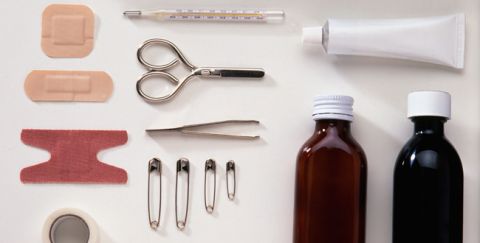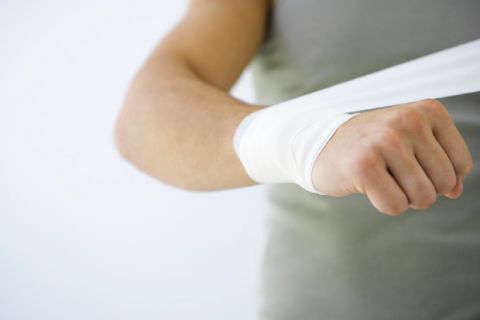9 First Aid Mistakes You're Probably Making
Spread butter on a burn? That's crazy! While most of us know to ignore that old wives tale, we're still making plenty of first aid mistakes that are either not helpful or downright dangerous. "I'm surprised all the time by how clueless even educated people can be in an emergency—either because they never learned what to do or because the protocol has changed," says Michael Van Rooyen, MD, professor of emergency medicine at Harvard Medical School. "For most of us," he says, "knowing some very basic first aid would go a long way." Here, the biggest blunders we're making in everyday emergencies and how to manage them like a pro.

Mistake #1: Disinfecting cuts and scrapes with hydrogen peroxide, rubbing alcohol, iodine or betadine
Yes, it's smart to disinfect fresh wounds, but not with an antiseptic solution. "They don't help and they can actually hurt," says Van Rooyen, who is interim chair of the department of emergency medicine at Brigham and Young Women's Hospital in Boston. That bubbling you see with hydrogen peroxide may look like germ-killing in action, but the only thing dying is your body's fibroblasts, the skin cells responsible for healing wounds. And that stinging with alcohol? It's healthy tissue being harmed.

Do it right: Run the tap. The best way to clean debris and bacteria from a cut or scrape is to hold it under the faucet and "wash it like crazy," Van Rooyen says. If it keeps bleeding, apply direct pressure, same as with a nosebleed. After flushing the wound, you can add a little antibiotic ointment like Bacitracin or Neosporin—although there's never been data to show that it prevents infection, it may help create a protective barrier, Van Rooyen says—and just cover with a loose bandage or let it air out if possible. The body will then mobilize white blood cells to rush over and form a scab, which in most cases you should leave alone, as it adds a sterile covering that allows healing to continue underneath.
Mistake #2: Tilting your head back to stop a bloody nose
"It's tempting to tilt the head back because nose bleeds look like a horror show—there's a bunch of blood and everybody's dabbing and gagging, thinking they're going to die," Van Rooyen says. But by tilting the head back, you're just draining blood back into the throat. "You drink blood, you throw up, you don't know how much you're bleeding and most important, you're not stopping the bleeding."

Do it right: Keep the head upright, which lowers blood pressure in the veins of the nose, and use your thumb and index finger to pinch both nostrils shut for 15 minutes, breathing through your mouth. After 15 minutes (time it), let go, and if the nose is still bleeding, go back to applying direct pressure for another 15 minutes. "Most nosebleeds are benign and will resolve on their own,” Van Rooyen says. Call a doctor if the bleeding doesn't stop after 30 minutes or if it happens after an injury, like a car accident.
Mistake #3: Assuming the closest hospital is best for your emergency
It may seem like a no-brainer to get to a doctor ASAP, but sometimes it's wiser to keep driving. "If you're having a certain type of heart attack for example," says paramedic Scott Matin, a board member of the National Association of EMTs, "you'll be better served at a hospital that can perform angioplasty."

Do it right: In an emergency, your first course of action is still to call 911, but be prepared to travel. If the 911 operator or the ambulance staff recommend a specialty center that's farther away than the nearest hospital, go with it. There are four types of specialty centers—cardiac, stroke, burn and trauma, and depending on your emergency, their services that could mean the difference between life and death. "If hospital A is 5 minutes away and hospital Z is 20 minutes away, people get nervous about taking the extra time to go farther," Matin says. "But once you're there, hospital Z will do things that hospital A can't."
Mistake #4: Performing CPR by alternating chest compressions with mouth-to-mouth resuscitation
Forget the mouth thing. The American Heart Association is now calling for hands-only CPR. “One of the big pieces of research on CPR has found that the more time you’re not doing compressions, the worse it is for patient,” says Matin. In fact, a new report from the Institute of Medicine found that only 1 in 20 of the annual 400,000 people who have cardiac arrest outside of hospitals survive—a number that could be significantly improved if people knew the right way to do CPR.
Do it right: If someone drops in front of you, feel for a pulse in the neck. If you don't detect one, start compressions immediately (while someone else calls 911). Place the heel of your hand in the center of the chest, place your other hand on top of it, and push down two inches with each compression—really indent the chest—about 100 times per minute. That's more than one compression per second (the song "Staying Alive" by the BeeGees has the perfect beat for this). Get a primer on how it's done by downloading the free Pocket First Aid & CPR Smartphone App, which is based on the American Heart Association's latest guidelines.
Mistake #5: "Rescuing" survivors of a car accident
You see this in movies all the time, but don't do it. "One of the most dreaded injuries, especially after a car accident, is to the cervical spine or neck," Van Rooyen says. "By moving a person without properly immobilizing them first, they can get paralyzed."
Do it right: Call 911 and leave the heavy lifting to the EMTs. In the meantime, just make sure the person is breathing and is as comfortable as possible. Assure him or her that help is on the way and stick around until the ambulance shows up.
Mistake #6: Popping Tylenol like baby aspirin
It's easy to take too much of this popular painkiller and fever reducer. "Acetaminophen is a great drug but it has to be used wisely," Matin says. Taking more than the FDA-recommended max—4,000 mg a day, or 6 to 8 Extra Strength Tylenol gel caps—can literally kill you. According to the National Institutes of Health, acetaminophen overdose is the most common poisoning around the world. And while you may be thinking, "I always stick to the recommended dose," you may not realize that acetaminophen shows up in many over-the-counter preparations, such as Nyquil, Sudafed and Alka-Seltzer Plus Liquid Gels, as well as in prescription painkillers such as Percocet and Vicodin. (Cleanse your liver with the 12-day detox for total body health in Heal Your Whole Body. Bonus: you could lose up to 13 pounds in 2 weeks!)

Do it right: Don't skip Tylenol if you need it. "It's been proven to alleviate pain in a lot of circumstances and also helps with recovery," Matin says. Just be vigilant about staying within your daily limit, which involves checking for acetaminophen in any other drugs you're taking (it can be listed as APAP, AC, Acetaminophen, Acetaminoph, Acetaminop, Acetamin, or Acetam, per the NIH). If you've studied the label and you're still unsure, ask your doctor or pharmacist.
Mistake #7: Reaching for Syrup of Ipecac after a suspected poisoning
Research shows that ipecac doesn't reduce ER visits or save lives. "It's the rare occasion that you can bring enough stuff back up to make it worth it," Van Rooyen says. What's worse, you run the risk of burning the esophagus again or sucking the poison back into the lungs after vomiting, which makes it far more toxic than swallowing it alone.
Do it right: If you suspect a poisoning—your child took pills from grandma's purse, your spouse mixed cleaning fluids and can't stop coughing, or the liquid in that glass wasn't soda—call the Poison Control Center Hotline. Even ER docs do it. Here's why: Some things you'd think are highly toxic are completely benign, like a bunch of Motrin, a tube of toothpaste or even gasoline, Van Rooyen explains. Then there are things that seem harmless but are deadly, like iron tablets for a toddler. You can reach any poison center in the country 24/7 by calling 1-800-222-1222, or get help online at webpoisoncontrol.org.
Mistake #8: Tying a tourniquet on an arm or leg to stop heavy bleeding
This old Boy Scouts trick goes in and out of vogue, but stopping the flow of blood to a body part hikes the risk of permanent tissue damage and even loss of the limb. "Say you slice open an artery in your arm and you're spurting blood like a fountain," Van Rooyen says. "Using a tourniquet would cut off all circulation to that extremity—and not accomplish anything that applying direct pressure can't accomplish."

Do it right: Using sterile gauze or a clean cloth, apply firm pressure to the wound and keep pressing even if the bandage gets soaked with blood. (You can add other cloths on top as needed.) "You just need a finger to control the bleeding until the person can be seen in the ER," Van Rooyen says. The rare exceptions are when a limb is amputated and the person is bleeding out. The Red Cross advises seeing a doc if the bleeding doesn’t stop or if the wound is gaping, dirty, or comes from an animal bite.
Mistake #9: If someone is having a seizure, putting a pencil in her mouth to keep her from swallowing or biting her tongue
Not only is it physically impossible to suck your tongue down into your throat, but trying to prevent such a thing from happening is risky. "If you put an object in her mouth during a seizure, she could swallow it," Van Rooyen says. "Something like a pencil or wallet could block the airway or she could suck it down once she starts to breathe again." And the risk of her choking on the object is greater than any potential benefit of preventing her from biting her tongue.
Do it right: During a seizure, people may twitch violently, foam at the mouth and even turn blue. But seizures are self-limiting, which means they'll stop by themselves—so there's nothing you can do except call for help and keep the person away from surrounding danger. "Protect them from things that could harm them, like sharp objects, glass, heat or falling in water," Van Rooyen says. You can also roll the person onto his or her side, to help keep the airway clear. It helps to keep in mind that seizures can seem like an emergency—with all that thrashing around and eyes rolling up into their head—but they're usually not.
(photos and story from prevention.com)








